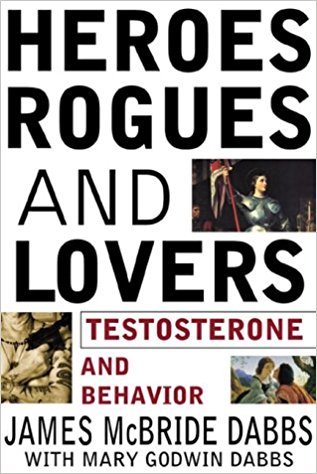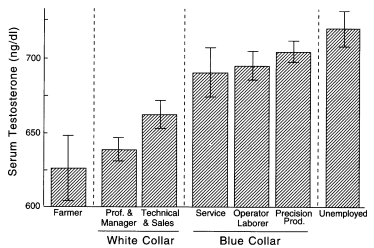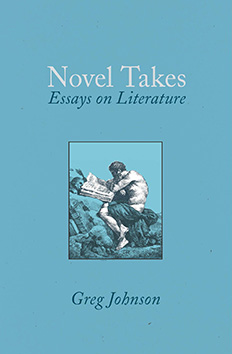The Chemistry of Human Differences
Thomas Jackson, American Renaissance, July 2001
James Dabbs, Heroes, Rogues, and Lovers: Testosterone and Behavior, McGraw-Hill, 2000, 285 pp.
One of the most destructive myths of our time is the idea that men and women are equivalent in temperament and act differently only because they are reared differently. Only fanaticism or years of indoctrination could make anyone believe something so silly, but there has been plenty of both. Of the many false egalitarian doctrines, however, this one is probably the most badly wounded. It is only a matter of time before it dies.
Heroes, Rogues, and Lovers, by Georgia State University psychology professor James Dabbs, is one of many recent books to explore the science of sex differences, and it does so by concentrating on the effect of just one substance: testosterone. Although he ignores racial differences, and seems hazy about how intelligence interacts with testosterone, Prof. Dabbs has otherwise written a good, readable account of how hormones affect both men and women.

Testosterone (T) is the quintessential male hormone that makes men dominant, libidinous, and attractive to women. High-testosterone (HT) men have larger muscles, are more self-confident, don’t follow rules, tend to baldness, are prone to violence, like to fight, and are more likely to have tattoos than other men. They are confrontational and like to take charge. They often end up in blue-collar jobs or as criminals, but they can also be explorers, war heroes, or flashy trial lawyers. Everyone has some notion of what testosterone does, and Prof. Dabbs says all people — rich, poor, old, young, men, women — wish they had more of it.
Many people don’t realize women produce T, though only at about 10 or 12 percent of the male level. It affects women just as it does men, making them more aggressive, sexual, and man-like. It is harder to study in women because the amount in the blood varies with the menstrual cycle. T levels are highest at ovulation, when both a woman’s fertility and sexual desire are greatest.
Testosterone is hard at work before a child is even born, preparing the body to produce and react to T. Even in early childhood, boys clearly like to assert themselves while girls prefer to befriend each other. Girls with twin brothers are more masculine than singleton girls because they shared the womb with a little T factory.
The testosterone level for both sexes peaks at around age 20, then gradually declines. Interestingly, in women after menopause, the decline in the female hormone progesterone is faster than that of testosterone, leaving the male hormone relatively more prominent than in younger women. This is why old women tend to become mannish: hairy, low-voiced, and rough-skinned. Women are more sensitive to small changes in testosterone levels, which is why steroids, which act like male hormones, boost a woman’s athletic performance more than they do a man’s. More T (and steroids) help sprinters more than they do marathoners because they build fast-twitch muscles.
HT women tend to have HT daughters, and although it is the sperm from the father that determines the sex of a child, HT women tend to have more sons than daughters. Perhaps there is something in their wombs that encourages implantation of male fetuses. Conversely, feminine women who are high in progesterone tend to have more daughters.
A woman’s testosterone level is one of the best predictors of how often a couple has sex. This does not appear to be because the woman necessarily initiates sex but because she is more likely to be receptive when the man does. “Butch”-type lesbians have more testosterone than “femmes,” though lesbians in general appear not to have higher testosterone than other women.
Testosterone is central to the best-measured differences between men and women: the female superiority with words and the male superiority with numbers and spatial relations. It is generally supposed that women evolved to be more verbal because they needed to form networks of friends to support themselves and their children, whereas men had more straightforward ways of getting what they needed.
Men are also more single-minded, and able to stick with projects that take months or years, while women are more easily distracted and have more diffuse interests. According to one theory, women had to be less intently focused on what they did because there were always children in the background that needed watching.
Some of the most interesting evidence that T levels cause these sex differences comes from the experiences of women getting hormone treatments as part of sex-change operations. As more T makes them more masculine, their verbal ability declines, but they get better at fixing things. Women generally have finer hand coordination than men, but as T turns them into men they become clumsier. Sex hormones, as Prof. Dabbs explains, even explain where the body stores fat:
“Testosterone makes men store fat around their stomachs, where it can be easily burned off for energy in emergencies. Estrogen makes women store fat on their hips, buttocks, and thighs, where it tends to stay unless needed to make up food shortages during pregnancy or breast-feeding.”
T appears to be an essential ingredient in putting on a good show, having a commanding presence, or projecting confidence. As Prof. Dabbs explains: “Men who are high in testosterone think well of themselves. They see themselves as people of consequence. They don’t make little jokes about themselves or put themselves down.”
T levels are temporarily affected by victory or loss. If a man loses a fight or backs down in a confrontation his T level temporarily drops, but it goes up after winning. The contest need not be physical; winners in chess matches get a T boost, while the losers get a T slump. Prof. Dabbs speculates that this is nature’s way of protecting the losers. A man with temporarily low T is less likely to pick another fight he might lose. The winner on the other hand, is emboldened for the next contest.
Men smile less often than women, and HT men smile least of all. This is probably because smiling is a sign of friendliness and ingratiation, whereas HT-types get their way through domination rather than ingratiation. When asked to pose for a picture, LT men are more likely than HT men to smile, and when HT men smile, they put on a wolfish smirk rather than a broad smile that lights up the face. Prof. Dabbs says he has learned to tell T levels simply from the way a man looks. HT men have strong jaws and seem “more serious, tough, and hard.” Interestingly, LT men are more comfortable when they are by themselves, whereas HT men like to be around others. Perhaps they need constant grist for their desire to dominate.
Prof. Dabbs reports that the biggest audience for nature/wildlife films is young men — the group with the most T. They particularly like it when a predator stalks, catches, and kills its prey. No doubt the most enthusiastic patrons of the Coliseum were young men.
Scientists don’t yet know exactly how T works, but individual molecules of it last no more than a few hours before they are taken up by the body to do their job. The hypothalamus keeps the T level constant, and sees to it the body produces more if a man is preparing for a fight.
Testosterone influences the expression of certain genes. For example, impalas of both sexes have the same genes for horns, but it is only high levels of T that activate those genes, so only males have horns. Even plants produce testosterone. Alfalfa and clover, for example, make enough of it to control the fertility of grazing animals. Prof. Dabbs reports that each year in Australia a million sheep fail to have lambs because they have been temporarily sterilized from eating too much clover.
The Costs
Despite its glamour and swagger, testosterone has costs, and this book emphasizes them. HT men take risks, fight a lot, and kill each other off. They want and get a lot of sex, but they don’t like to stick around to rear children. They tend not to marry, and to get divorced when they do. If they do stay with a woman they are not very happy.
T makes animals violent, too. Birds that have been injected with an extra dose sing more, try to patrol a larger area, get into fights, and are less likely to live out the season. Males — including humans — live longer if they have been castrated. Prof. Dabbs cites a study of mentally retarded people that found eunuchs lived 13 years longer than intact men! By comparison, refraining from smoking increases life expectancy by only 4.9 years.
Not surprisingly, prisons are full of HT men (and women). Violent offenders and ones that break prison rules have the most T. Male prisoners tend to sort themselves out into a pecking order, with the meanest, highest-T man at the top, and the LT patsies at the bottom. Female prisoners reportedly form small cliques rather than hierarchies. Like men, though, the most violent and aggressive have the most T.
There is a fine line between criminality and heroism. Prof. Dabbs points out that the men who make the best soldiers are likely to be HT-types who were troublemakers in peacetime, and that soldiers decorated for heroism are quite likely to have criminal records. Likewise, the policeman who gets citations for saving lives may well be the one who is disciplined for beating up perps. “Fearlessness and high testosterone often go together,” writes Prof. Dabbs, “with fearlessness making it easier for a high-testosterone person either to mistreat others or to help them.” He adds that HT men sometimes appear to step in to protect a victim more because they want to punish an aggressor than because they want to help people in trouble.

As the chart above shows, different professions tend to attract men with different levels of T. Ministers (not on the chart) and farmers have the lowest levels perhaps, speculates Prof. Dabbs, because they spend their lives dealing with things they can’t control. Actors have the highest T, closely followed by professional athletes. Even ordinary men, however, sometimes act like HT-types; airlines don’t like to have a bunch of men sitting in an airplane’s emergency-exit row because they are likely to get into a fight over who is in charge of the exit rather than make sure everyone gets off.
As Prof. Dabbs points out, HT boys don’t like to sit still in school. Also, they tend to speak and write poorly, which makes them bad students. Not surprisingly, it is men with the least T who stay in school longest, and this is one reason intellectuals are liberal. They are verbal, LT-types who think like women.
Prof. Dabbs notes that T has a lot to do with tribal consciousness, and a vivid sense of one’s own group interests, and that men feel much more strongly about these things than women. He also cites research that showed “more men than women favored inequality among social groups, military programs, and punitive public policy, whereas more women than men favored equal rights and social programs.” Men and women have different politics, and T has a lot to do with it. LT men are more altruistic — and more like women in their politics — than HT men.
Prof. Dabbs suggests men are better off being more like women: “Low-testosterone people tend to be more friendly, more intellectual, and more interested in the welfare of others than are high-testosterone people. Low-testosterone people tend to do better in school, have higher-status occupations, feel closer to their friends and families, and have happier marriages.” This may be true, but the author is also a liberal college professor.
Heroes, Rogues, and Lovers is informative but very timid. Although Prof. Dabbs does concede that men and women are different, he writes as if this had no social consequences. Never does he suggest that biological sex differences explain why men and women differ in career choice, political participation, sexual behavior, and a thousand other ways. Different sex roles are part of nature, but Prof. Dabbs cannot bring himself to say so.
As for racial differences, he does venture to say that climate may influence T-related behavior. Where winters are harsh, children may die without the protection of a man, so men who live in the north are more likely to help look after children. Prof. Dabbs even hints there is a biological basis for this, but quickly drops the subject.
Prof. Dabbs seems to have read just about everything ever written about T, but never mentions that blacks have the most T, whites somewhat less, and Asians the least. This helps explain race differences in crime, illegitimacy, violence, drop-out rates, and much more, but Prof. Dabbs, who brags about his father’s civil rights work and who thinks Head Start was a great success, probably left this out deliberately.
Also, he touches only briefly on the connection between intelligence and T, noting only that in adolescent boys, high intelligence seems to make up for some of the negative effects of T. In fact, among HT men, the smart ones are far less likely to end up in jail or abandon their children, and research shows that the combination of high intelligence and HT is an excellent indicator of success in life. This is bad news for blacks, who are more likely to have the unfortunate combination of low intelligence and HT — which is doubtless why Prof. Dabbs skirts the subject.
Testosterone explains a great deal about how people differ, but this book concentrates only on the differences that are least controversial — differences between individual men — and then suggests high testosterone levels are really a curse anyway. Testosterone has great explanatory power with respect to sex and race differences, but Prof. Dabbs apparently does not have enough testosterone to write about them.















